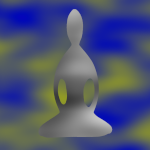Dear Friends,
I’ll start with this quote, often attributed to Viktor Frankl:
Between stimulus and response lies a space. In that space lie our freedom and power to choose a response. In our response lies our growth and our happiness.
Yesterday, I invited you to turn your attention to the “flavor” of an experience – to notice whether an experience is pleasant, unpleasant, or neither. Today, we’ll follow along this to notice what often happens when things are pleasant, or unpleasant, or neutral.
Last spring, Jeanne offered a daylong retreat on a teaching called Dependent Origination, which traces how things can be conditioned by what comes before. In Jeanne’s retreat, we focused on the middle links in the chain, which Bhante Gunaratana also reviews in chapter 6 of The Four Foundations of Mindfulness in Plain English.
As an example, consider a simple act of seeing.
Light hits an object, and bounces to your eye (a sense organ), which fire some signals that reach the brain, which registers “seeing” (consciousness). The combination of these three things (object + organ + consciousness) is called contact. Contact conditions some kind of feeling (seeing a pretty flower may be pleasant; seeing a pile of dirty dishes may be unpleasant; seeing the walls in a familiar hallway might not evoke much of a response – neutral).
What’s interesting is to notice what happens next… Our evolutionary background has conditioned our systems to consider what is pleasant to be desirable, and so we want it; what is unpleasant is not desirable, and so we push it away; and if it’s neutral, we generally just ignore it as we scan for other things that might be pleasant or unpleasant. In that regard, we’re not much different than an amoeba that will move towards a source of sugar and move away from a source of poison. However, if we continue to react in this amoeba-like fashion, we get caught in the same old ruts that cause the same old suffering and discomfort.
(A former co-worker used to say, “If you always do what you’ve always done, you’ll always get what you’ve always got.”)
Last winter, I took an online class called Entering the Path (EtP), which featured several video lectures by various scholars and teachers. Bhikkhu Anālayo gave a couple of lectures on this topic. One of the things he noted was that “everything we do is conditioned; nothing we do is determined.” This means that as we bring mindfulness to our daily lives, we can make wiser decisions, and thus have the ability to gradually change the conditioning, which will get us out of those old ruts. (Science calls this neuroplasticity!)
Bhikkhu Anālayo also says that although we are not helpless victims, we are also not fully in control. There are so many factors (conditions) that come into play at any given moment. This is a good reminder that we need to be patient and practice compassion when things don’t go the way we hoped!
Bhikkhu Anālayo’s lecture included this:
Everything is a process, and since everything keeps changing, by making wise decisions, practicing meditation, slowly this set of conditions will change until the conditions that lead to unwholesome reactions are completely gone from the mind … The key point in all of this is feeling: being aware of the impact of feeling on the mind … Just this bare knowing takes us forward in the path of deconstructing the negative conditions, liberating the mind from the conditions that lead to our harm, and the harm of others.
If you want to investigate this topic further, Shaila Catherine gave a talk on feelings and decision making:
http://www.dharmaseed.org/teacher/163/talk/46775/
The coursework for EtP suggested a reflection on this topic:
When mindfulness is not present, pleasant feeling-tone tends to lead habitually to greed or compulsion, unpleasant feeling-tone to hatred or aversion, and neutral feeling-tone to ignorance or delusion. … whenever you notice beginning to be pulled into one of these three [kinds of craving] – either in formal meditation or daily life – see if you can trace the chain reaction back to that first “hit” of pleasant, unpleasant, or neutral …. Does seeing [this] more clearly help release the reaction to it?
I invite you to share your reflections in the comments below. or send me an email.
With best wishes,
Andrea

The last quote struck home for me. The actual experience of something being pleasant or unpleasant or neutral seems relatively innocuous. It is the perpetuation of that experience that leads to the final state of suffering. Never quite thought of that before. The analogy of the parallax…. where what seems like a small degree of difference in the moment spread over time or a lifetime leads to a huge shift.
RND